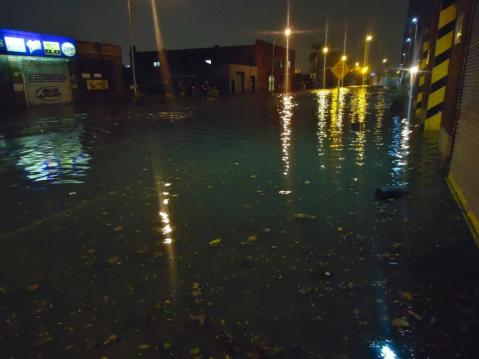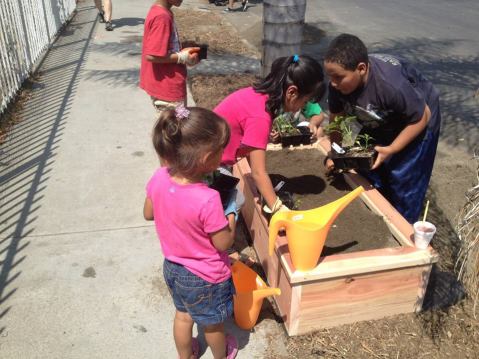LA Waves Parkway Planting Permits to Create Opportunities in Food Deserts
In my last post, I highlighted an innovative program in Toronto which brings a mobile produce market to communities who lack access to affordable and healthy food. In an effort to address healthy food access in similarly underserved neighborhoods across the US, some community residents have literally taken action into their own hands by transforming underutilized and sometimes unlikely patches of land into “guerrilla” gardens.
Trees, wildflowers, herbs, fruits and vegetables pop up in vacant lots, alleys, tree pits and even parkways (the planted strip of land between the curb and the sidewalk), providing aesthetic value, helping to oxygenated the air and clean the soil, as well as providing families with an opportunity for healthy eating. Parkways are often owned by a city but the responsibility for maintenance falls on the adjacent homeowner. These spaces have a lot of potential for urban gardening because they are right outside of a house or apartment building and are a manageable size. Some parkways go ignored, some become planted, and others become community resources.
In 2010, gardener and activist Ron Finley co-founded LA Green Grounds, a group who plants and tends gardens created in parkways and other underutilized spaces with the hope of creating a food and health revolution in underserved South Los Angeles. In 2013, Mr. Finely gave a TED Talk (above) where he discussed the inspiration for the parkway garden he created in front of his home. Mr. Finley, who grew up in South Los Angeles and raised his children there, asked the audience, “…I was wondering, how would you feel if you had no access to healthy food, if every time you walk out your door you see the ill effects that the present food system has on your neighborhood? I see wheelchairs bought and sold like used cars. I see dialysis centers popping up like Starbucks. And I figured, this has to stop. So I figured that the problem is the solution. Food is the problem and food is the solution. Plus I got tired of driving 45 minutes round trip to get an apple that wasn’t impregnated with pesticides.”
Prior to a 2013 amendment to the City’s “Residential Parkway Landscaping Guidelines”, it was illegal to plant fruits and vegetables in parkways, but due to the activism of Mr. Finley and many others, the LA City Council decided to make an exception for vegetable gardening. While this news was a step in the right direction for urban gardeners and community health advocates, the permit to plant anything other than grasses and certain shrubs, still carried a cost-prohibitive $400 price tag. But just this week, the LA City Council voted to waive the $400 fee for parkway gardens (excluding fruit trees). The City Council will still have to define the parameters of the law (regulating garden height and addressing concerns such as safe passage for pedestrians) and the ordinance will be subject to final Mayoral approval, but waiving the fee will be a significant win for advocates and paves the way to increase the opportunity for residents to bring fruits and vegetables in to their neighborhoods without the worry of fines hanging over their heads.
My Finley says: “I have witnessed my garden become a tool for the education, a tool for the transformation of my neighborhood. To change the community, you have to change the composition of the soil. We are the soil. You’d be surprised how kids are affected by this. Gardening is the most therapeutic and defiant act you can do, especially in the inner city. Plus you get strawberries.”
Hurricane Sandy Brings Environmental Concerns to Light
After Hurricane Sandy, the Environmental Protection Agency (EPA) posted information on its website about taking safety precautions when cleaning up after floods but many community advocates in New York and New Jersey are increasingly concerned about the levels of contamination caused by Sandy and their impact on clean up efforts as well as the environmental threat of future storm surges and rising seal levels near current and former industrial waterfront areas.
In Brooklyn, New York, two Superfund (hazardous waste) sites, the Newtown Creek and Gowanus Canal breached their banks and flowed in to nearby city streets. In New Jersey, the Raritan Bay Slag Superfund Site (containing large amounts of lead, arsenic and copper) flooded an adjacent public playground and beach and in the Arthur Kill (a channel between New Jersey and Staten Island), clean up crews working in cooperation with the Coast Guard had to use oil skimmers, vacuum trucks and a contamination boom to remove 378,000 gallons of fuel released from the Motiva oil tank during the storm.

Greenpoint Avenue (near a sewage treatment plant) in Greenpoint, Brooklyn after Hurricane Sandy. Photo by Newtown Creek Alliance
Environmental justice (advocating for communities unfairly burdened by environmental pollution and contamination) advocates are requesting to meet with local city officials and waterfront businesses to inventory existing chemicals and help keep businesses up to date on floodproofing their chemical storage facilities. Kate Zidar, Executive Director of the Newtown Creek Alliance says “Learning from Sandy, we need environmental health and safety information for flooding that is specific for Superfund and relevant to the industrial business community,” and suggests potential efforts that could help prevent further contamination in the future like installing tide gates and shoreline bulkheads and the restoration of our wetland areas.
Communities who live near businesses like chemical plants, paper mills, and ports or infrastructure like highways are unfairly burdened by negative health outcomes and advocating for regulation of these facilities, progressive environmental planning and affordable housing in healthier communities are key to saving millions of our fellow citizens from undue suffering.






